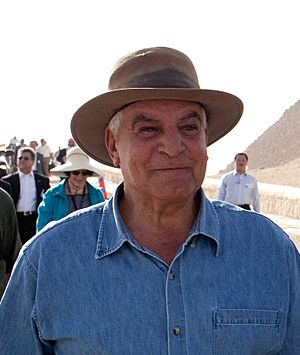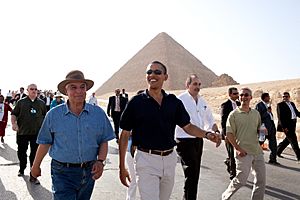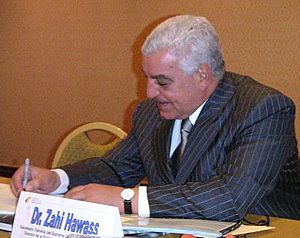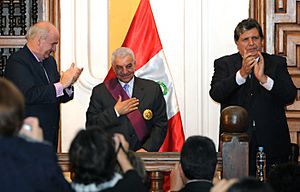Zahi Hawass facts for kids
Quick facts for kids
ORE
Zahi Hawass
|
|
|---|---|
| زاهي حواس | |
 |
|
| 1st Minister of Antiquities | |
| In office January 31, 2011 – March 3, 2011 |
|
| President | Hosni Mubarak |
| Prime Minister | Ahmed Shafik |
| Preceded by | Office created |
| Succeeded by | Mohamed Ibrahim Ali |
| In office April 5, 2011 – July 17, 2011 |
|
| Prime Minister | Essam Sharaf |
| Succeeded by | Mohamed Said |
| Personal details | |
| Born | May 28, 1947 Damietta, Egypt |
| Alma mater | University of Pennsylvania (MA, PhD) Cairo University Alexandria University (BA) |
| Profession | Egyptologist |
Zahi Abass Hawass (Arabic: زاهي حواس; born May 28, 1947) is a famous Egyptian archaeologist and Egyptologist. He used to be the Minister of Tourism and Antiquities for Egypt. He has explored many ancient sites across Egypt, including the Nile Delta and the Western Desert.
Contents
Early Life and Education
Zahi Hawass was born in a small village near Damietta, Egypt. When he was young, he wanted to be a lawyer. However, he earned a degree in Greek and Roman Archaeology from Alexandria University in 1967.
In 1979, he received a special diploma in Egyptology from Cairo University. After that, he worked at the Great Pyramids as an inspector. This job meant he helped manage and explore ancient sites.
When he was 33, Hawass received a special scholarship called a Fulbright Fellowship. This allowed him to study Egyptology at the University of Pennsylvania in the United States. He earned two master's degrees in 1983 and his PhD in Egyptology in 1987. His PhD research focused on the burial places of ancient kings like Khufu and Khafra.
Career in Archaeology
Zahi Hawass has spent most of his career working on important archaeological sites in Egypt. He has led many excavations and restoration projects.
Early Archaeology Work
From 1968 to 1974, Hawass was involved in excavations at places like Hermopolis and Tarrana. Since 1975, he has been in charge of digging and restoring sites all over Egypt, especially at the Giza pyramids.
Between 1969 and 1975, he also worked as an Inspector of Antiquities. This meant he oversaw many archaeological teams, including those at Abydos, Egypt and Abu Simbel.
Hawass also taught Egyptian archaeology and history at universities. He taught in Egypt and the USA from 1988 to 2001. He wanted to create a plan to protect and restore historical monuments. He also aimed to train Egyptians to become experts in excavation and preservation.
Work at Giza

Hawass was the Inspector of Antiquities for Giza from 1972 to 1974. He became the Chief Inspector in 1980. In 1987, he became the Director General of the Giza monuments. This important role covered sites like Giza, Saqqara, Memphis, and Dahshur.
He briefly left this position in 1993 but returned a few months later. This happened after the Egyptian Antiquities Organization became the Supreme Council of Antiquities. In 1998, he was promoted to Undersecretary of the State for the Giza Monuments.
Hawass continues to work on archaeological projects in Egypt. As of 2017, he led the science team for the ScanPyramids project. This project uses new technology to explore inside the pyramids.
Political Roles
In 2002, Hawass was appointed as the Secretary General of the Supreme Council of Antiquities. This was a very important job in protecting Egypt's ancient treasures. When US President Barack Obama visited Cairo in June 2009, Hawass personally guided him through ancient Egyptian sites.
At the end of 2009, President Hosni Mubarak promoted him to Vice Minister of Culture.
Egyptian Museum Incident (2011)
During the Egyptian protests in January 2011, the Egyptian Museum in Cairo was broken into. Hawass arrived to find many display cases damaged. He reported that 13 cases were destroyed.
He later told The New York Times that thieves broke about 70 objects while looking for gold. They also took two skulls from a research lab. However, they were stopped before leaving the museum. Hawass said that the broken objects could all be fixed.
Minister of Antiquities
On January 31, 2011, Zahi Hawass was appointed as the Minister of State for Antiquities Affairs. This was a brand new government position. He stated that he would continue his work in archaeology and ensure that Egypt's sites were safe. He also worked to get stolen ancient objects returned to Egypt.
Hawass reported that 18 artifacts, including statues of King Tutankhamun, were stolen from the Egyptian Museum. These included wooden statues and a statue of Nefertiti. He resigned from this role on March 3, 2011. This happened after a list of looted sites during the protests was shared.
He was reappointed Minister of Antiquities on March 30, 2011. However, he resigned again on July 17, 2011.
Discoveries and Appearances

Hawass is known for many important discoveries. These include the tombs of the pyramid builders at Giza. He also found the Valley of the Golden Mummies at Bahariya. At Giza, he uncovered a smaller pyramid next to Khufu's pyramid.
In 2005, he led a team that used CT scans on the mummy of King Tutankhamun. This was part of a project to learn about health and diseases in ancient Egypt. His team continues to scan mummies to solve mysteries about ancient lives.
Hawass has appeared on many TV shows and documentaries. He has been on the National Geographic Channel, the History Channel, and the Discovery Channel. He also appeared in the show Digging for the Truth, discussing mummies and pyramids. In 2010, he was on a reality TV show called Chasing Mummies.
In February 2006, Hawass worked with Egyptologist Otto Schaden to open Tomb KV63. This was the first complete tomb found in the Valley of the Kings since 1922. In June 2007, Hawass announced that his team might have found the mummy of Hatshepsut in tomb KV60.
He also hosted the documentary Egypt's Ten Greatest Discoveries.
Views on Ancient Egypt
Zahi Hawass has strong opinions on various topics related to ancient Egypt.
Returning Artifacts to Egypt
Hawass has led many efforts to bring important Ancient Egyptian artifacts back to Egypt. These items are currently in museums in other countries. Some examples he has campaigned for include the Rosetta Stone from the British Museum and the bust of Nefertiti from Berlin.
In 2003, he said that if the British Museum wanted to restore its reputation, they should return the Rosetta Stone. He called it "the icon of our Egyptian identity." He has stated that he will make it difficult for anyone who keeps Egyptian monuments outside of Egypt.
In 2019 and 2022, Hawass relaunched his campaigns. He asked museums like the British Museum and the Musée du Louvre to return or lend artifacts to the new Grand Egyptian Museum.
DNA Testing of Mummies

Hawass has been careful about using DNA testing on Egyptian mummies. He has said that it is not always accurate for mummies. In 2000, he denied a request from Japanese and Egyptian teams to do DNA tests.
However, in February 2010, Hawass and his team announced they had analyzed mummies, including Tutankhamun's. They suggested that King Tut might have died from malaria after a leg injury.
A 2020 study, which Hawass signed, looked at the DNA of Tutankhamun's family. It found that the Y-chromosome haplogroup of the family was R1b. This haplogroup is also found in modern Egyptians.
On Afrocentrism
Hawass has disagreed with claims that ancient Egyptian history is primarily Afrocentric. He explained that images on Egyptian temples show differences between Egyptians and people from other regions like Africa, Libya, and Syria.
He appeared in a documentary about Cleopatra after a Netflix film caused controversy. Hawass stated that Macedonian queens, like Cleopatra, were not Black. However, he also said that suing Netflix would not be successful because of freedom of opinion.
In 2023, after a lecture, an audience member asked why he "attacked" African Americans. Hawass replied that he was not attacking them. He explained that ancient Egyptian civilization developed in Egypt, using local resources like granite from Aswan and limestone from Tura. He emphasized that it was an Egyptian-made civilization.
Aliens and the Pyramids
Hawass has also spoken out against ideas that aliens built the pyramids. He criticized a tweet by Elon Musk that suggested this. Hawass said that studying ancient Egyptian civilization helps us understand its secrets. He believes that such claims show a lack of knowledge about Egyptian history. He often points to the Diary of Merer and the tombs of pyramid builders as proof that Egyptians built the pyramids.
Biblical and Quranic Stories
Hawass has stated that archaeological findings do not prove that Moses or Joseph lived in Egypt. He also said there is no proof of the Exodus of the Israelites from Egypt in ancient records. He believes these events happened, but archaeology has not yet found direct evidence. He added that there is no archaeological proof of which pharaoh ruled during the time of Moses and Joseph.
Personal Life
Zahi Hawass is married to Fekrya Hawass, who is a gynecologist. They met in 1967. They have two sons. One is a doctor, and the other runs a restaurant, both living in Cairo.
He was a close friend of the actor Omar Sharif. Hawass also organized private tours of Egypt's ancient sites with Jehan Sadat, the former First Lady of Egypt, for many years.
Even though his name sometimes makes people think he is a Coptic Christian, Hawass is Muslim.
Awards and Honors
Hawass has received many awards for his work. He received the highest Egyptian state award for his work on the Sphinx restoration. In 2001, he won a silver medal from the Russian Academy of Natural Sciences. In 2002, he received the Golden Plate from the American Academy of Achievement for protecting ancient Egyptian monuments.
In 2006, Time magazine named him one of the world's 100 most influential people. He has also received many honorary doctorates from universities around the world. These include the University of Pennsylvania and the University of Lisbon.
Honors from Countries

Hawass has received special honors from several countries:
 Algeria: Knight of the National Order of Merit (Algeria)
Algeria: Knight of the National Order of Merit (Algeria) Austria: Grand Decoration of Honour in Silver with Star
Austria: Grand Decoration of Honour in Silver with Star Egypt: Grand Cordon of the Order of Merit (Egypt)
Egypt: Grand Cordon of the Order of Merit (Egypt) France: Officer of the Ordre des Arts et des Lettres
France: Officer of the Ordre des Arts et des Lettres Italy: Commander of the Order of Merit of the Italian Republic
Italy: Commander of the Order of Merit of the Italian Republic Japan: Gold and Silver Star of the Order of the Rising Sun
Japan: Gold and Silver Star of the Order of the Rising Sun Peru: Grand Cross of the Order of the Sun of Peru
Peru: Grand Cross of the Order of the Sun of Peru Poland: Officer of the Order of Merit of the Republic of Poland
Poland: Officer of the Order of Merit of the Republic of Poland Spain: Knight of the Order of Arts and Letters of Spain
Spain: Knight of the Order of Arts and Letters of Spain
Publications
Hawass has written and co-written many books about Egyptology. Some of his well-known books include The Curse of the Pharaohs: My Adventures with Mummies and King Tutankhamun: The Treasures from the Tomb. He also writes regularly for Egypt Today magazine.
Main Books
- The Great Book of Ancient Egypt: In the Realm of the Pharaohs, 2018
- Giza and the Pyramids, 2017
- Scanning the Pharaohs: CT Imaging of the New Kingdom Royal Mummies, 2016
- Highlights of the Egyptian Museum, 2011
- Cleopatra: The Search for the Last Queen of Egypt, 2010
- King Tutankhamun: The Treasures of the Tomb, 2008
- Mountains of the Pharaohs: A History of the Pyramids of Egypt, 2006
- Tutankhamun and the Golden Age of the Pharaohs: A Souvenir Book, 2005
- How The Great Pyramid Was Built, 2004
- Curse of the Pharaohs: My Adventures With Mummies, 2004
- Hidden Treasures of Ancient Egypt: Unearthing the Masterpieces of Egyptian History, 2004
- The Treasures of the Pyramids, 2003
- Secrets from the Sand: My Search for Egypt's Past, 2003
- The Mysteries of Abu Simbel: Ramesses II and the Temples of the Rising Sun, 2001
- Valley of the Golden Mummies: The Greatest Egyptian Discovery Since Tutankhamun, 2000
See also
 In Spanish: Zahi Hawass para niños
In Spanish: Zahi Hawass para niños

